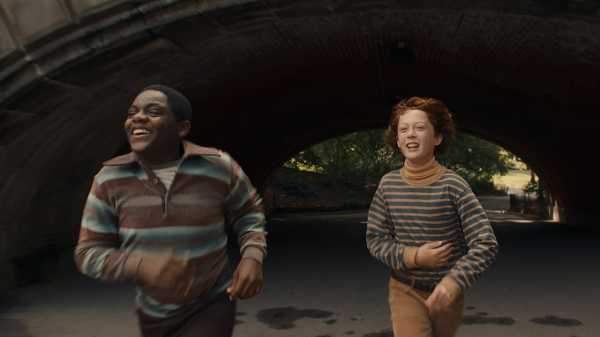
When “Armageddon Time” premièred, at Cannes, I wrote that it places late-twentieth-century Queens at the epicenter of recent American societal pathologies. It depicts that borough’s white middle class as a hotbed of casual racism, a beneficiary of the baked-in racism of mainly white-run institutions, and the vanguard of the reactionary right’s—and the Trump family’s—political emergence. The movie’s drama, set in 1980 and based largely on its writer and director James Gray’s childhood memories, involves his alter ego, a sixth grader named Paul Graff (Banks Repeta), as he becomes aware of the endemic privileges and unquestioned injustices of which he himself is a prime beneficiary. In rewatching the film now that it’s in commercial release, I found my attention drawn to its emphasis on the underlying source of Paul’s coming to consciousness—namely, his secular New York Jewish background, one very much like Gray’s own. “Armageddon Time” is more than the acknowledgment of a grievous social ill in need of redress, more than a negative. It’s also a positive vision of a catalyst for political progress: the alliance of the Jewish community with the Black community. The film roots that perspective in the protagonist’s personal experience—and also in a historical point of view that reaches far beyond the confines of Paul’s Queens neighborhood.
Paul’s mother, Esther (Anne Hathaway), a home-economics teacher, is the president of the PTA in Paul’s public elementary school; his father, Irving (Jeremy Strong), is an electrical contractor. They live in a small house within walking distance of Paul’s school, the real-life P.S. 173. (I grew up about a mile east of it.) Paul’s paternal grandfather, Aaron Rabinowitz (Anthony Hopkins), a constant presence in the Graff household, is the son of a refugee from Ukraine and was raised in England before coming to the United States in his own youth. I once met someone who said that his religion was Socialist and his politics were Jewish. Although “Armageddon Time” has little to do with either Socialism or religion, it’s a film that defines in action the meaning and the basis of Judaism as essentially and specifically political.
I’ll try to avoid spoilers, because I’ve seen “Armageddon Time” twice and can attest to the thrilling dramatic shock of going in cold. The movie is, in effect, a naturalistic horror story of a practical crime and a moral crime. Paul, an aspiring young artist and something of a class clown, is also a loner who, on the first day of class—Monday, September 8, 1980—forms a quick friendship with another young, solitary, and funny classmate, Johnny Davis (Jaylin Webb). Johnny is Black, is repeating sixth grade, and is relentlessly harassed by the class’s white, middle-aged, and ill-tempered teacher, Mr. Turkeltaub (Andrew Polk). Johnny is virtually raising himself (he lives with his grandmother, who is afflicted with dementia), whereas Paul is growing up in relative comfort (he mistakes his parents’ fretful middle-class sufficiency for wealth). When their adventures get them into trouble, Paul receives a beating from his father and gets sent to a strict and stuffy local private school, where the Trump family figures prominently. Paul and Johnny seek an out from their lives, and Paul comes up with a scheme; Johnny goes along with it, and, when it goes awry, the fallout unsurprisingly proves much more consequential for Johnny than it does for Paul.
The interstices of “Armageddon Time” are filled with the cultural effluvia of secular New York Jewry, starting with the neighborhood itself—when Mr. Turkeltaub calls the roll, its first few names include Ashkenazy, Breslow, and Cohen. The extended Graff family’s weekend breakfast involves bagels and lox, Aaron speaks to Esther in Yiddish when keeping a secret in front of Paul, and Paul’s parents speak with an instantly identifiable, emphatic lilt that’s built on the inflections of their own parents’ Yiddish. A death in the family involves the ritual of sitting shiva, but it mostly means that dinner will be late—there’s little religion in the household. On the other hand, Paul learns the story, from his great-aunt Ruth (Marcia Haufrecht), of her work in Czechoslovakia, for the U.S. government, reuniting displaced persons at the end of the Second World War—and pointing to kiddush cups (for Sabbath dinner) that she’d brought back, relics of Jews who’d been killed in the Holocaust.
Paul’s closest family bond is with his grandfather Aaron. Along with copious presents and candy and hearty encouragement and tender solicitude, what Paul gets from him—now that he has seemingly come of age to hear it—is the story of how Aaron got to America. It’s a story of persecution and violence, of the pogrom in Ukraine, in which Aaron’s maternal grandparents were killed in front of their daughter, a teen-age girl who then fled the country and made her way to Liverpool, where she married and bore Aaron before immigrating to the U.S. Aaron adds to this story the exhortation to “never, ever forget the past, because you may never know when they’ll come looking for you.” In another scene of affectionate but gruffly candid communion between grandfather and grandson, Paul talks about the racist remarks made by students at his new private school, and Aaron asks what he did in response. “Obviously nothing, of course,” Paul says; Aaron’s reply, though warm and loving, is also sharp, reproachful, and hortatory. Paul has to “say something,” Aaron insists, and reminds him, “You were raised better than that.” He tells Paul to “be a mensch,” that Black people don’t have Paul’s “advantages,” and that the same people who make racist remarks would just as likely vilify Jews. In other words, he portrays Jewish alliance with Black people not as a matter of self-interest but as a matter of self-awareness—both of Jewish identity and of Jewish humanistic values.
I’m treading carefully around plot points, but suffice it to say that Paul’s “nothing” in response to racist offenses—a “nothing” from which Paul benefits—is the moral void around which the entire movie is organized; it’s a marker of the cowardice that wrenches him out of the innocent audacity and private pain of his childhood and burdens him with a lifetime of shame and guilt, a sense of outward responsibility for a debt that he will never be able to repay. Even as Paul’s father tells him, “Don’t look back,” Paul is haunted by Aaron’s lesson to keep the horrors of history prominently in mind and his exhortation: “Don’t ever give in to those bastards.” (“Armageddon Time” becomes something of a political ghost story, the formation of a political superego by way of a spectral memory.) Paul, with the benefit of his whiteness, has been able to make his way in a world that accepts him as it doesn’t accept Johnny; but, Aaron warns, this acceptance is provisional and deceptive. The very fact of being both similarly hated and differently advantaged imposes a moral responsibility on Paul and on all American Jews.
From the rest of his family, however, Paul gets mixed messages. When Irving mistakes Johnny (whom he’s never met) for a prowler, the scene spotlights another racist shibboleth: the association of Black people with crime—a scurrilous association that still carries significant political weight. Paul’s grandmother Mickey (Tovah Feldshuh), a retired teacher and Aaron’s wife, complains about the influx of Black students in Paul’s school; Esther sharply reproaches her for this remark, but it’s hardly the only bit of casual racism that Paul encounters at home. (In fact, the New York City public-school system played a central role, during the nineteen-sixties, in fracturing the political alliance between Jewish and Black New Yorkers. The flash point was the effort of parents in Black neighborhoods to seek local control of the schools and, thereby, to hire Black teachers. Because teaching was a job to which many Jewish New Yorkers had gravitated, local control was fiercely resisted by the teachers’ union and led to a bitter strike, in 1968.)
The tangle of mixed messages that Paul gets, at home and in public, creates in his mind a virtual siren wail of disordered thoughts and conflicting imperatives, and it’s amplified by his unclear friendship with Johnny. That friendship is sketched in a handful of sharply delineated scenes that also make clear Johnny’s inner conflicts. He is one of the few Black students in a predominantly white school; he’s something of a nerd whose ambition is to become an astronaut; he’s culturally clued in enough to introduce Paul to early works of hip-hop, by Kurtis Blow and the Sugar Hill Gang, but—in an exemplary scene that takes place on a subway train—it’s clear that many within the Black community don’t quite understand Johnny (and maybe vice versa) and that, when he’s faced with his own outsiderness, his response is to withdraw, to shut down, to push Paul aside.
When I first saw “Armageddon Time,” I was surprised and dismayed that Gray didn’t develop Johnny’s life in greater detail, even from Paul’s perspective, even if the drama emphasized, in this one brief but forceful scene, Johnny’s unwillingness to let Paul very far into it. Yet I also noted that Gray hardly develops Paul’s life in detail, either; despite a few subjective touches involving fantasies and memories, the movie is strangely tacit about Paul’s reflections. The character of Paul is somewhat tamped down, and also effaced. (For instance, he has little of the precocious intellectual excitement of the child at the center of Mike Mills’s “C’mon C’mon.”) For Gray, Paul is largely a recording device whose progress through life accretes its experiences and its influences and leaves his ideas and his point of view tacit and implicit. This is no failure of omission; it’s an exemplary aspect of Gray’s career-long aesthetic, a hallmark of his artistry, but one that plays a new role in this most personal of films.
I’ve long considered Gray’s hard, physically and emotionally bruising cinematic realism to be a faux realism, in a positive sense, and “Armageddon Time” highlights the peculiar singularity of that form. His representational images and consistent dramatic and character psychologies mask a shatteringly intense subjectivity—his own—and a maelstrom of historical forces. He puts unbearable pressure on his images from both sides—from behind them with his inner life and in front of them with social conflicts—and, when it converges at the membrane of his images, it tears the images apart, squeezes them into unrecognizable distortions, and thereby proves cinematically that the ongoing power of history and the immediate furies of inner life are inseparable and inextricably connected. There are moments in the film where, outwardly, little is happening, but, inwardly, time seems to dilate to an epochal scale.
Generally, post-screening Q. & A.s are beside the point; the better a movie, the less I want to hear talk about it, even from its creators, immediately afterward. When possible, I make an exception for Gray, because he’s one of the great in-person performers among directors. Not only is he a thoughtful cinematic philosopher but he’s a brilliant comedian—an impersonator of voices, a natural funny person. His temperament is florid, expansive, exuberant, even when his reflections are shadowed with the tragic consciousness that informs his movies. One would hardly know that personality from his movies, and this isn’t a problem (though I’ve long wished that he would indeed make an outright comedy and act in it), yet in “Armageddon Time” it is a paradox. In constructing a movie of memories, Gray himself seems to be looming just outside the frame, shaping his reminiscences; he’s embodied in the movie’s fiercely controlled and emotionally ravaged form, its howling stillness, its vast moral spectrum.
There’s a second history that’s exerting pressure on the faux-realistic images of “Armageddon Time”: the history of cinema. In his passionate fealty to the outward forms of the great realistic tradition, whether of Francis Ford Coppola’s nineteen-seventies films or the work of Akira Kurosawa, Gray is extending that tradition for a new generation, opening up a future history for it, and affirming its formative role in his own artistic consciousness. Yet the intensely personal substance of “Armageddon Time,” its dramatization of memory as an urgent form of present-tense action, calls out for a fracturing of its solid dramatic framework—not a restoration of classical cinematic styles but an innovation at the level of Gray’s personal insights. It’s a first-person film in which the sublimation of Gray’s voice into familiar styles is something of a mismatch. “Armageddon Time” is the natural movie with which to unscrew the screws of a compact psychological drama and cut loose with a narrative messiness that would effect a severe self-questioning of Gray’s aesthetic roots, along with his moral ones.
What many of Gray’s modern Hollywood predecessors have had—and what Gray hasn’t—is well-deserved popular success. Though he’s in his early fifties, he is, shockingly, unestablished. He has suffered from the mishandling of such films as “The Yards,” “Two Lovers,” and “The Immigrant” from their producers and distributors (including, alas, Harvey Weinstein), and he didn’t have final cut on “Ad Astra.” I’m not sure that there’s a working filmmaker whose sense of craft and whose narrative antennas are so sharply sensitized, whose sense of form is as sensually immediate, and yet who hasn’t had an incontestable hit—a movie that wins the critical acclaim, the commercial success, and the awards-season harvest of the sort that liberates filmmakers from some of the industry’s strictures, from the drive to make their name, from their own habits and inclinations. (Perhaps the greatest self-renewal in the recent American cinema, that of Martin Scorsese in the past decade-plus, arose from his Oscar for “The Departed” and its box-office success.) As great as “Armageddon Time” is, it’s also a film of memories that belongs in part to the artistic past, when its emotional furies are pressing ahead to make it new. ♦
Sourse: newyorker.com






